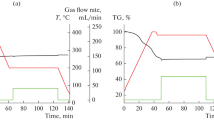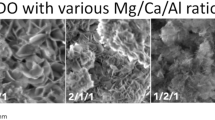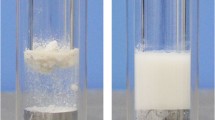Abstract
Sorption-enhanced reverse water–gas shift (SE-RWGS, here designated as ‘COMAX’) was studied with bifunctional reactive sorbents. First proof-of-concept is presented of the successful design of a multifunctional reactive sorbent, which combines CO2 activation and water adsorption functionalities in an integrated reactive sorbent, i.e. the active phase is loaded on the carrier that provides surface area for dispersion of the active (Pt, Cu) phase as well as H2O sorption capacity. Near complete selectivity to CO was achieved from atmospheric pressure up to at least 29 bar, i.e. the highest pressure studied in the experimental campaign. This selectivity was obtained with stoichiometric and excess quantities of hydrogen in the (RWGS) COMAX feed, the latter in view of the potential use of syngas mixtures. The newly developed bifunctional material bears important additional advantage for scaling up of the COMAX process, because it avoids the mixing of catalyst and adsorbent materials that differ in properties such as hardness. Evidently, the key parameter for optimizing the COMAX process is the working adsorption capacity of the system and (multi-column) cycle design. Improving the capacity can be done by optimizing the reactive adsorption conditions and by optimizing the regeneration method.
Graphic Abstract







Similar content being viewed by others
References
Yu KMK, Curcic I, Gabriel J, Tsang SCE (2008) Chemsuschem 1:893–899
Detz RJ, Reek JNH, van der Zwaan BCC (2018) Energy Environ. Sci. 11:1653–1669
Van Os P (2018) Greenhouse Gases: Sci Technol 8:994–997
Kätelhön A, Meys R, Deutz S, Suh S, Bardow A (2019) Proc Natl Acad Sci USA 116:11187–11194
Skorikova G, Saric M, Sluijter S, van Kampen J, Sánchez-Martínez C, Boon J (2020) Front Chem Eng 2:e594884
Park SH, Kim HJ, Lee CS (2010) Fuel Proc Techn 91:504–513
Porosoff MD, Yan B, Chen JG (2016) Energy Environ Sci 9:62–73
Carvill BT, Hufton JR, Anand M, Sircar S (1996) AIChE J 42:2765–2772
van Kampen J, Boon J, van Berkel F, Vente JF, van Sint Annaland M (2019) Chem Eng J 374:1286–1303
Campbell JA (1985) J Chem Ed 62:231–232
Ghodhbene M, Bougie F, Fongarland P, Iliuta MC (2017) Can J Chem Eng 95:1842–1849
van Kampen J, Boon J, van Sint Annaland M (2020) Adsorption 12:1–13
Arunajatesana V, Subramaniama B, Hutchenson KW, Herkes FE (2007) Chem Eng Sci 62:5062–5069
Dietz L, Piccinin S, Maestri M (2015) J Phys Chem C 119:4959–4966
Boon J, Cobden PD, van Dijk HAJ, Hoogland C, van Selow EV, van Sint Annaland M (2014) Chem Eng J 248:406–414
Klier K, Young CW, Nunan JG (1986) Ind Eng Chem Fundam 25:36–42
Klier K (1984) Appl Surf Sci 19:267–297
van Kampen J, Boon J, Vente JF, van Sint Annaland M (2020) J CO Util 37:295–308
van Kampen J, Booneveld S, Boon J, Vente JF, van Sint Annaland M (2020) Chem Comm 56:13540–13542
Acknowledgements
Dr. Alfons Brandt of Chemiewerk Bad Köstritz GmbH is kindly acknowledged for providing 13X BFK sample. The authors thank Rick Broers for discussions on material selection. The project has received funding from ACT ALIGN-CCUS (No 271501) that received funding from RVO (NL), FZJ/PtJ (DE), Gassnova (NO), UEFISCDI (RO), BEIS (UK) and is co-funded by the European Commission under the Horizon 2020 programme ACT, Grant Agreement No 691712.
Author information
Authors and Affiliations
Corresponding author
Additional information
Publisher's Note
Springer Nature remains neutral with regard to jurisdictional claims in published maps and institutional affiliations.
Rights and permissions
About this article
Cite this article
Pieterse, J.A.Z., Elzinga, G.D., Booneveld, S. et al. Reactive Water Sorbents for the Sorption-Enhanced Reverse Water–Gas Shift. Catal Lett 152, 460–466 (2022). https://doi.org/10.1007/s10562-021-03645-1
Received:
Accepted:
Published:
Issue Date:
DOI: https://doi.org/10.1007/s10562-021-03645-1




